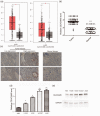CEACAM5 stimulates the progression of non-small-cell lung cancer by promoting cell proliferation and migration
- PMID: 32993395
- PMCID: PMC7536504
- DOI: 10.1177/0300060520959478
CEACAM5 stimulates the progression of non-small-cell lung cancer by promoting cell proliferation and migration
Abstract
Objective: To detect the expression of CEA-related cell adhesion molecule 5 (CEACAM5) in non-small-cell lung cancer (NSCLC) and explore its function in the progression and development of NSCLC.
Methods: qRT-PCR and immunohistochemistry were performed to detect CEACAM5 expression in human NSCLC tissues and cell lines. The correlation between CEACAM5 expression and the clinicopathological features of patients with NSCLC was also investigated. MTT, colony formation, wound healing, and immunoblot assays were performed to detect the functions of CEACAM5 in NSCLC cells in vitro, and immunoblotting was used to detect the effects of CEACAM5 on p38-Smad2/3 signaling.
Results: CEACAM5 expression was elevated in human NSCLC tissues and cells. We further found that CEACAM expression was correlated with clinicopathological features including T division, lymph invasion, and histological grade in patients with NSCLC. The in vitro assays confirmed that CEACAM5 depletion inhibited the proliferation and migration of NSCLC cells by activating p38-Smad2/3 signaling. We verified the involvement of CEACAM5 in the suppression of NSCLC tumor growth in mice.
Conclusion: CEACAM5 stimulated the progression of NSCLC by promoting cell proliferation and migration in vitro and in vivo. CEACAM5 may serve as a potential therapeutic target for the treatment of NSCLC.
Keywords: CEA-related cell adhesion molecule 5; Non-small-cell lung cancer; migration; p38–Smad2/3 signaling; proliferation; therapeutic target; tumorigenesis.
Figures





References
-
- Siegel RL, Miller KD, Jemal A. Cancer statistics, 2019. CA Cancer J Clin 2019; 69: 7–34. - PubMed
-
- Gray-Owen SD, Blumberg RS. CEACAM1: contact-dependent control of immunity. Nat Rev Immunol 2006; 6: 433–446. - PubMed
-
- Fahlgren A, Baranov V, Frangsmyr L, et al. Interferon-gamma tempers the expression of carcinoembryonic antigen family molecules in human colon cells: a possible role in innate mucosal defence. Scand J Immunol 2003; 58: 628–641. - PubMed
-
- Taheri M, Saragovi U, Fuks A, et al. Self recognition in the Ig superfamily. Identification of precise subdomains in carcinoembryonic antigen required for intercellular adhesion. J Biol Chem 2000; 275: 26935–26943. - PubMed
MeSH terms
Substances
LinkOut - more resources
Full Text Sources
Other Literature Sources
Medical

